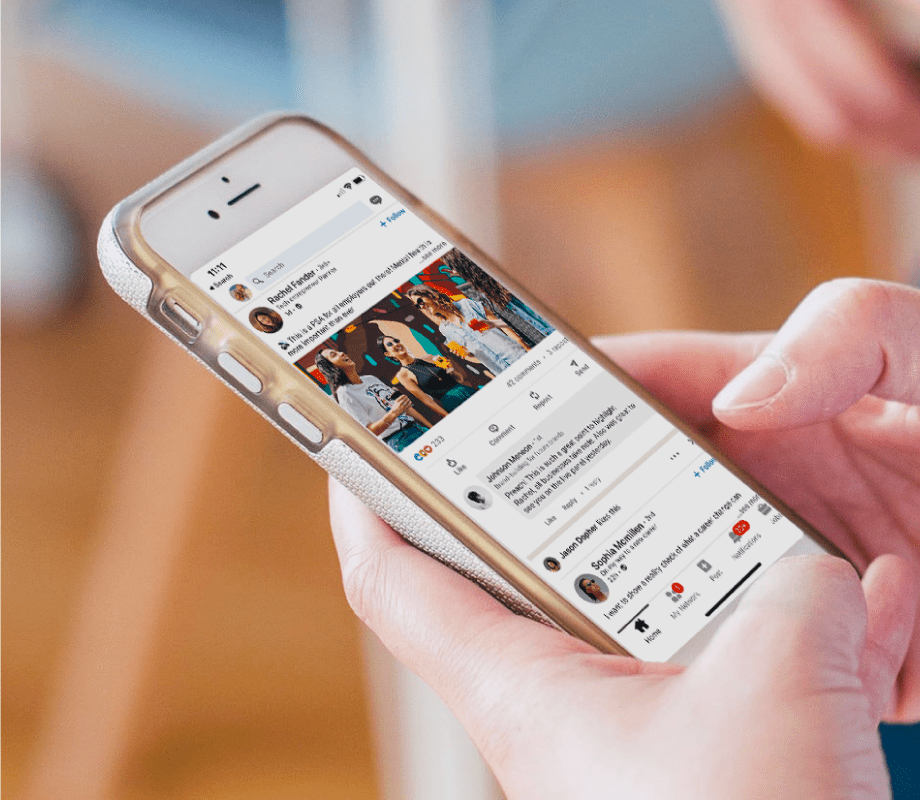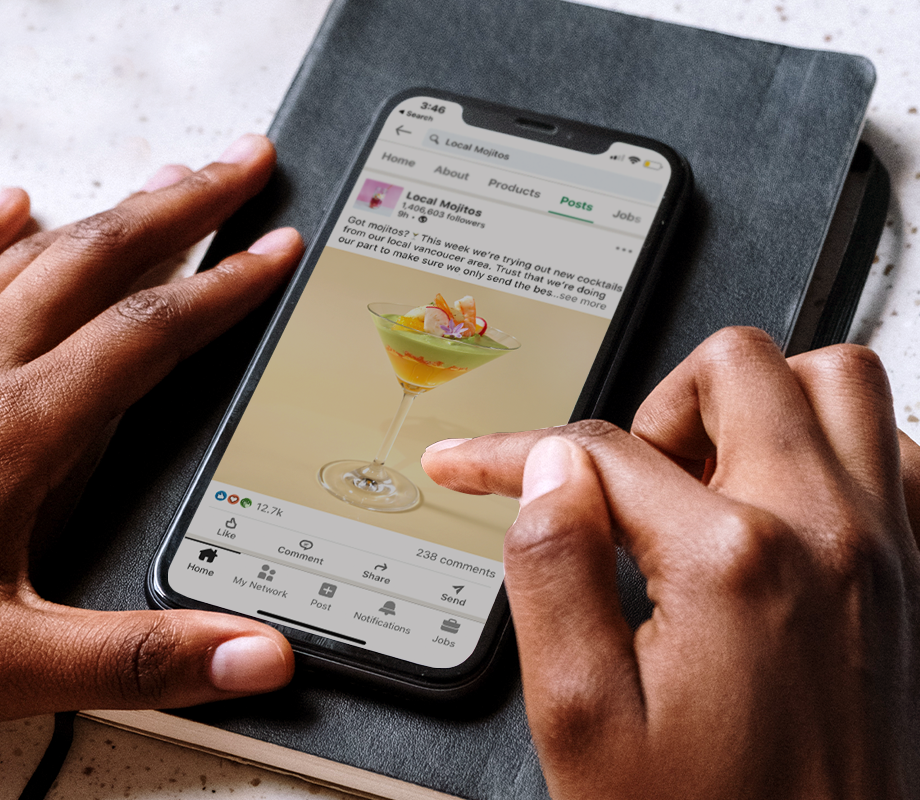Contrary to popular belief, LinkedIn isn’t only for recruiting purposes. At least, not anymore.
Case in point: LinkedIn influencers — the newest thought leaders shaking up the creator economy.
We spoke to two LinkedIn influencers to learn who these creators are, why LinkedIn is an underrated platform, and how you can find success on LinkedIn in five steps.
Table of Contents
Who Are LinkedIn Influencers?
Also known as “LinkedInfluencers,” a LinkedIn influencer is someone who has mastered the art of personal branding and content strategy on the platform.
They’re thought leaders as much as they are active community members — and they frequently spark thoughtful conversations with their audience.
Most notably though, they’re not the stereotypical businessperson carrying a briefcase — they’re creators like Brandon Smithwrick and Sophie Miller:
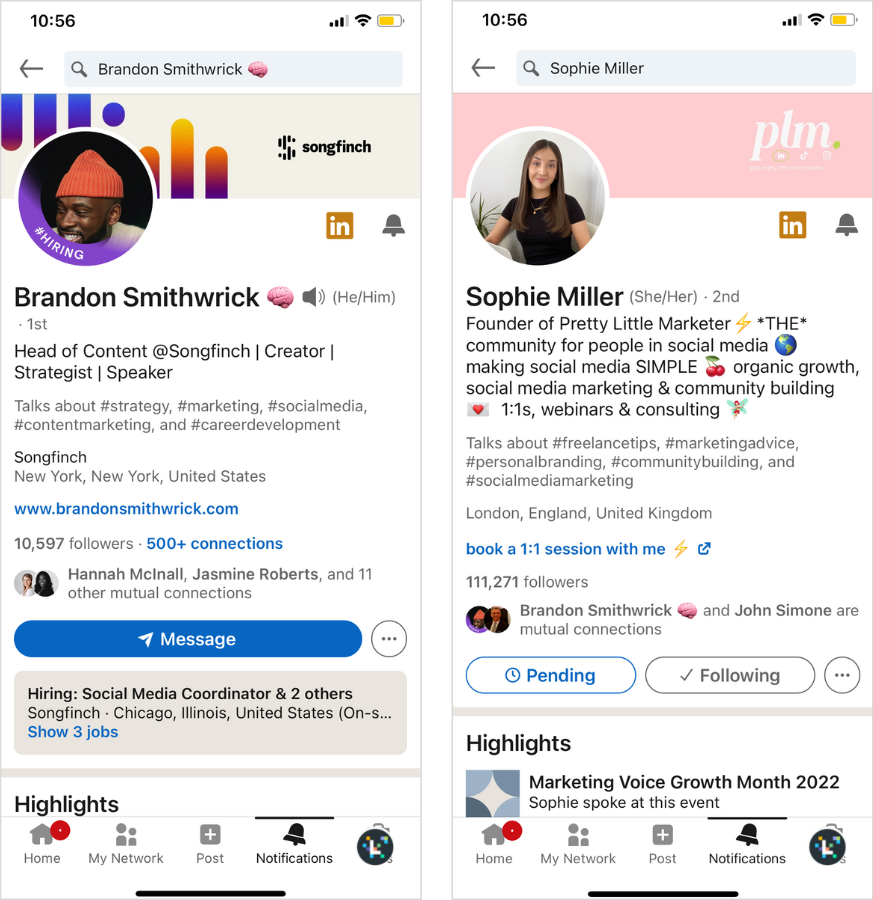
And they hold all the tips and tricks to help you make your mark on LinkedIn.
FYI: With Later's influencer marketing solutions, enterprise businesses can discover new creators to partner with — across multiple social channels. Learn more.
Why Should Creators Use LinkedIn?
Two words: organic reach.
Brandon, the new Head of Content at Songfinch, recently hit 10.5K followers on LinkedIn (in under 6 months).
He explains that the platform has given him a better ROI in building his personal brand versus other channels:
“[It’s] brought me a new job, podcast and blog features, speaking engagements, thought leadership opportunities, and freelance consultant gigs.”
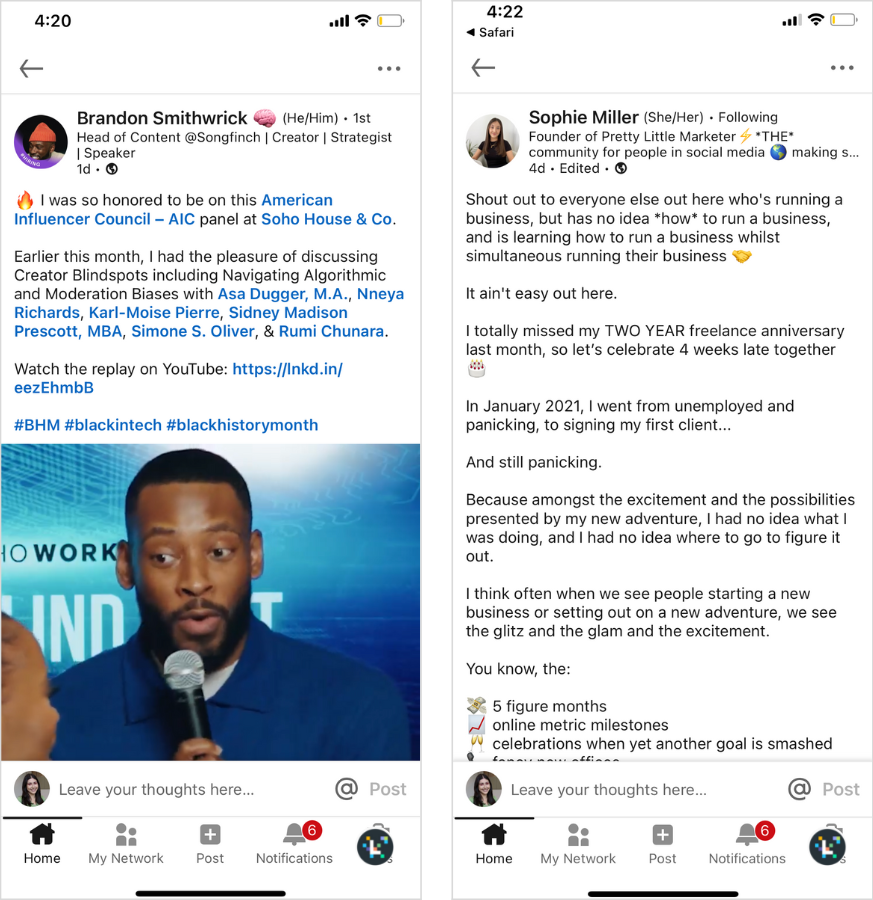
Brandon’s sentiment rings true for Sophie.
Not only has LinkedIn grown her marketing community, Pretty Little Marketer (135K followers and counting) — it’s also created tons of opportunities both as an individual and a professional.
“You’re able to tap into hidden job or client markets," Sophie says.
"The more people that know you, the more opportunities are likely to come your way.”
And with something as simple as a like or comment putting you in front of these opportunities, the possibilities for success on LinkedIn are truly endless (more on that, later).
Psst, with Later's social media management platform, you can schedule your social posts in advance — LinkedIn included. Create an account today:
Who Can Become a LinkedIn Influencer?
Spoiler: anyone can become a LinkedIn influencer.
The not-so-secret ingredient? Uniqueness.
“I think we expect ourselves to have like five PhDs and 10 businesses," laughs Sophie.
“But actually, it doesn't matter if you're a student, starting a business, or in a full-time role — we all have our own unique perspective.”
Brandon is aligned.
“The biggest credential for building a following is your opinion, your thoughts, and your unique point of view,” he says.
In other words (and in the least cliché way possible), be yourself.
TIP: Turn on LinkedIn creator mode to unlock in-app creator tools and get a head start on your LinkedIn influencer journey.
How to Become a LinkedIn Influencer in 5 Steps
If you've been looking for a sign to prioritize LinkedIn in 2023 — this is it.
Here’s how to become a LinkedIn influencer in five steps:
Define Your Goals
Prioritize Authenticity
Post, Post, Post
Engage Within & Outside of Your Network
Don’t Stick to One Niche
Step #1: Define Your Goals
We’ve said it before, and we’ll say it again — defining your goals is pivotal to your success on social media.
And LinkedIn is no different.
So, before you prepare your first post, it’s important to create SMART goals.
This way, you’ll have a clear idea of what “success” looks like for you on LinkedIn and how to drive your strategy forward.
Sophie reminds us: “If you were launching a new product, the first thing you would think about is your strategy,” she says.
“So, when we're marketing ourselves, why wouldn’t we do the same thing?”
TIP: Bookmark this post to help you set your own SMART goals: How to Set Social Media Goals in 2023 (+ Achieve Them!).
Step #2: Prioritize Authenticity
While LinkedIn is a professional network, it doesn't mean you have to post like a CEO.
Brandon’s recommendation? “Share the advice you wish you got, your thoughts on X topic, or your reaction to recent news.”
Likewise, Sophie shares a trick she learned from Amelia Sordell: type how you talk.
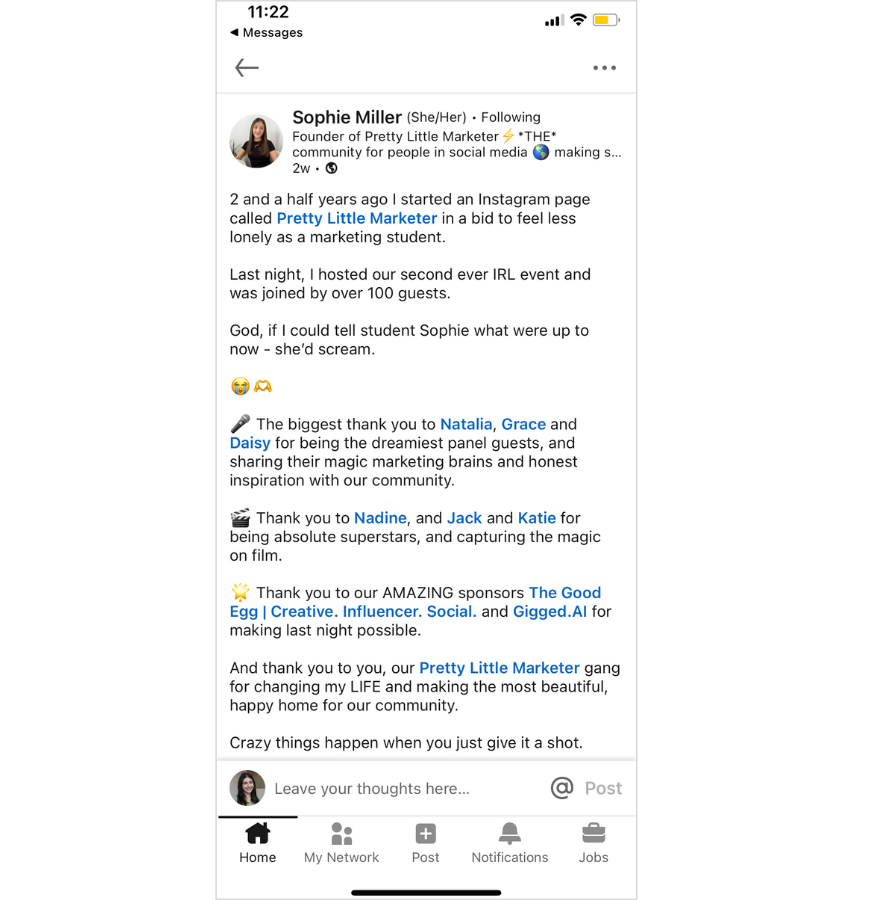
Not only can it streamline your writing — it’ll help you stay true to your brand.
“It creates a really authentic first impression,” Sophie explains.
The takeaway? Don’t let LinkedIn dim your brand voice (or emoji usage).
FYI: Later makes planning and scheduling your social media content easy. Share your unique thoughts and perspectives on LinkedIn in advance when you create a free account today:
Step #3: Post, Post, Post
Simple: you can’t grow on LinkedIn if you don’t share your golden thoughts and ideas.
And while Sophie’s found the sweet spot to be 2-3 posts a week, she acknowledges that sharing your unique perspective can seem scary and in her experience, cringe.
“When I first started posting on LinkedIn, an old coworker liked one of my posts, and I thought ‘Hell no — no one from real life can see me on this platform,’” Sophie recalls.
“So, I blocked everyone I know [except for] my best friend.”
Fast forward a few years and she has a combined LinkedIn audience of 200K+ followers.
Our advice? Embrace the cringe!
TIP: Discover the best time to post on LinkedIn so you can reach your audience when they're most active: The Best Time to Post on LinkedIn in 2023.
Step #4: Engage Within & Outside of Your Network
If a picture is worth a thousand words, a simple LinkedIn comment can unlock dozens of potential networking opportunities, sponsorships, and customers.
“The goal is to put yourself in rooms and conversations you might not be in because [potential connections and followers] don't know who you are,” Sophie says.
But it’s not only about connecting with new creators and brands.
You need to maintain strong relationships within your network too.
![Brandon Smithwrick comments on a LinkedIn post about content marketing.
The comment reads: "Jess I save so many of your posts for when I need to refer back to these gems. Keep 'em coming please [praying hands emoji]".](https://images.ctfassets.net/az3stxsro5h5/1PgDSnwJUkBwybuCvy1Jeh/e2732932097dfb95f8ed297ed73150e6/Vertical_Double_-New_iPhone-___16_.png?w=873&h=900&q=50&fm=png)
“Connect with others peers in your space,” Brandon reminds us.
“They are the ones who will engage with your content most.”
Aka, network, but don’t forget about your day ones.
Step #5: Don’t Stick to One Niche
Unlike other social media platforms, sticking to a single niche could actually hinder your LinkedIn growth.
Brandon recommends speaking to 3-5 content pillars, because “[t]hat diversity of subject matter helps your content from getting too mundane and widens your audience.”
His go-tos? Social media, career development, content strategy, and being Black in tech.
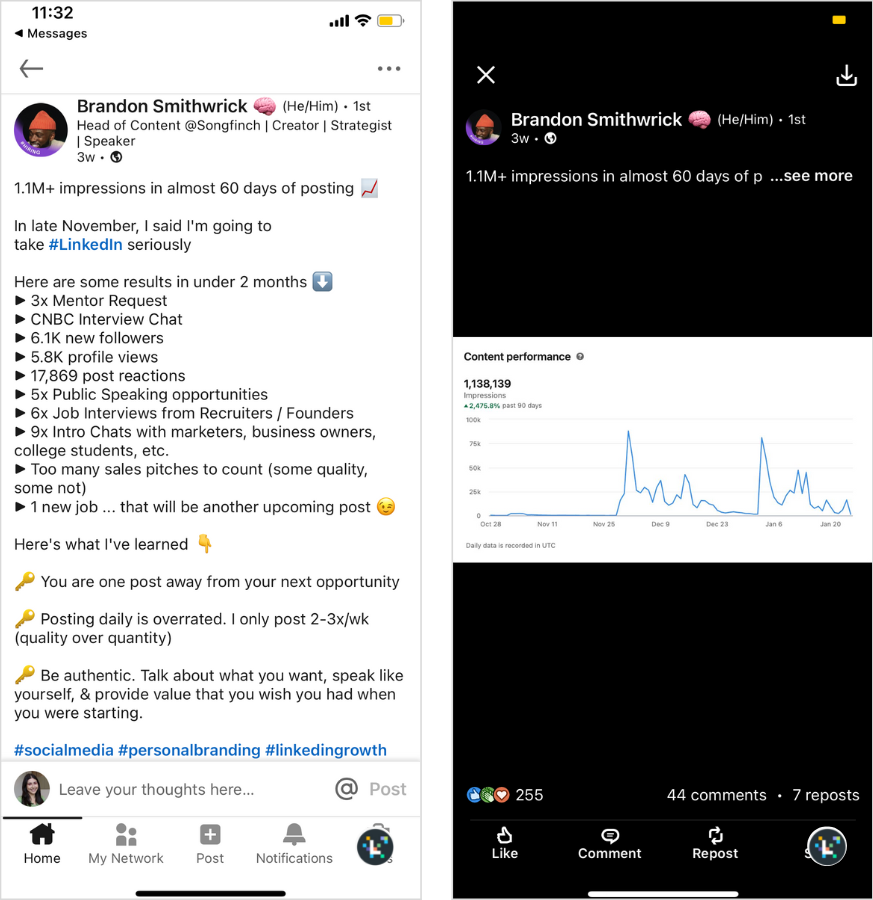
Coupled with his use of hashtags and relevant keywords, Brandon’s managed to rack up 1M+ impressions and 10K+ followers in just two months. 🔥
So, what are you waiting for?
There’s never been a better time to invest in your LinkedIn growth.
As long as you stay true to you, build lasting connections, and embrace the cringe, you’re bound to make a splash in this newfound creator economy pool.
We’ll see you on our LinkedIn feed.
